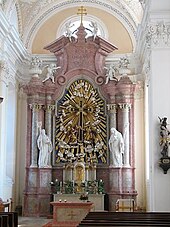Pilgrimage church Heiligenkreuz
The Roman Catholic pilgrimage church of Heiligenkreuz is about four kilometers northwest of Kremsmünster in Upper Austria . The church belongs to the Kremsmünster Abbey and was built in 1687–91 based on plans by Carlo Antonio Carlone . Approx. The local recreation and bird sanctuary of the Schachenteiche in the middle of the Schachenwald is a 15-minute walk away.
history
According to legend, the farmer Hans Adamsmayr was asked to erect a statue and an offering stick on his field in a dream at Easter 1682 , as a Florian church is said to have stood there before. That night, neighbors saw lights float around the farmer's house.
The farmer then went to the court judge at the time, Benedikt Finsterwalder von Kremsmünster, and received permission to erect a pillar on his field. This column was then visited by many believers (up to 100 per day) who donated abundantly to the offering box. Occasionally there was testimony of comfort and healing that some people had experienced.
Building and Church History
The abbot of Kremsmünster turned to the bishop of Passau to have a chapel built for prayer for the many believers. On January 28, 1683, the bishop approved the construction and thanks to the continued willingness to donate, a wooden chapel was built that same year. The willingness to donate reached its peak in 1685 and the then abbot Erenbert Schreyvogl (1669–1703) decided to build a stone building. The abbot thus fulfilled a vow that he had taken to avert the danger of the Turks and to spare himself from the plague .
Construction began in 1687 according to the plans of the Baroque master builder Carlo Antonio Carlone . On February 16, 1693, the first mass was read in the new stone building. After a break forced by lack of money, the work was continued in the years 1700 to 1702. The consecration of the bells took place in 1702 and the new high altar was built in 1706 , a work by Johann Bader. In 1711 the high altar was given the fire-gilded cross by Johann Kutter.
Nevertheless, the church was never completely finished, as the very simple nave and the unadorned appearance of the two tower facades show. The veneration of the Holy Cross more and more supplanted that of St. Florian and so the new name Holy Cross appeared for the first time in 1711 . On September 5, 1715, the church was rededicated by the Bishop of Passau.
Under Emperor Josef II , the church was closed by official order in 1786, but it was never closed or demolished.
From 1979 to 1986 the pilgrimage church was completely renovated. In 1996 the church got a new grille and St. Sebastian was brought back from the Sattledt parish church . In 2002 the high altar was renovated under Pastor Fr. Christoph Eisl.
Structure and equipment
The single-aisled, three-bay church with a stitch cap vault and a recessed choir faces west. The nave without a vestibule is 37 meters long, 14 meters wide and 15 meters high. The choir is richly stuccoed, in contrast to this, the nave has no decorations. The statue of the farmer from 1682 on the right was the cause of the first pilgrimage and bears frescoes of St. Florian and St. Leonhard and the birth and crucifixion of Jesus.
Pilgrimage today
The pilgrimage movement to Heiligenkreuz almost came to a standstill in the 20th century . After the Second World War , the Fatima celebrations began on the 13th of the month from May to October and are still held today.
The church is still often used for weddings, baptisms, May services and local pilgrimages.
Web links
Individual evidence
- ^ Christian Haidinger: Kremsmünster Abbey. In: Yearbook of the Upper Austrian Museum Association. Volume 130b, p. 148, entire article p. 147–150, PDF on ZOBODAT .
Coordinates: 48 ° 4 ′ 33.5 ″ N , 14 ° 5 ′ 54 ″ E




